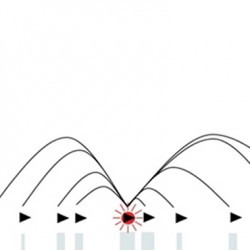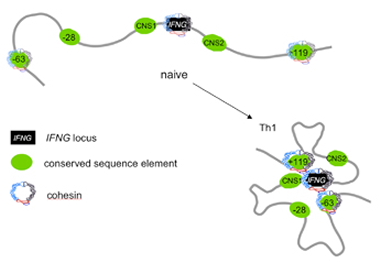 CSC Group demonstrates developmental role
CSC Group demonstrates developmental role
Work published in Nature this week demonstrates a new function for the chromosome cohesion complex.
Following DNA replication, sister chromatids are held together by a protein called cohesin, a ‘chromosome glue’ that also facilitates DNA repair.
In recent years, an additional role for cohesin as a regulator of gene expression has emerged from studies in model organisms and from human genetics. Slight disruption of cohesin binding has been implicated in disorders such as Cornelia de Lange Syndrome, which is characterised by potentially severe developmental anomalies. Cohesin therefore seems to be crucial for normal development, but the exact nature of its role, and the mechanism of its action, were unknown.
Last year, the CSC’s Lymphocyte Development Group, headed by Matthias Merkenschlager and Amanda Fisher, were one of four research groups to publish work showing that cohesin is recruited to specific sites by a DNA binding protein called CTCF. CTCF acts at chromatin structure boundaries and ‘insulator’ regions in the genome. The papers showed that cohesin was involved in CTCF’s ability to block interactions between sequences that control gene expression, such as promoters and enhancers. These findings provided a first explanation for cohesin’s involvement in gene regulation but raised new questions: firstly, what is the molecular mechanism of cohesin action on gene expression? – and secondly, can cohesin binding also promote gene expression?
To address these questions, a new study by Sue Hadjur and colleagues of the Lymphocyte Development Group focused on IFNG, a gene that contains a cohesin binding site and is situated between two additional cohesin binding sites. IFNG encodes a cytokine central to T helper cell differentiation – one of the best examples of genetically identical cells acquiring distinct expression programmes and biological roles. The team looked at CTCF and cohesin binding around IFNG during T helper cell differentiation and found increased CTCF and cohesin binding in TH1 cells, where IFNG is inducibly expressed. Next, they used restriction enzymes to systematically chop up the chromosome and then measured the ability of the fragments to re-ligate. The further the fragment was from IFNG, the less it was linked to IFNG. The CTCF/cohesin sites, however, showed a marked increase in linking.
The obvious explanation was the 3D organization of the cohesin binding sites: sequence elements that are far apart in the DNA sequence can be in close proximity in three dimensions because of chromosome looping. Interestingly, looping was cell type-specific and occurred preferentially in TH1 cells. But this raised another question: was the interaction due to the looping of a single chromosome, or was the interaction occurring between chromosomes?
Measurements made using 3D-FISH, a technique that reveals the distance between gene loci with fluorescent probes, suggested that the homologous chromosomes were too far apart to interact. TH1 and TH2 cells were also shown to have nuclei of similar size, ruling out the possibility that restricted space might force interactions in one cell type but not the other. Finally, the 3C interactions at IFNG were shown to occur before DNA replication, ruling out the possibility that the interactions occur between sister chromatids. The team concluded that the interactions most likely are between binding sites on the same chromosome, termed ‘in cis’. This is a novel function of cohesin, which was previously only known to hold sister chromatids together ‘in trans‘. The team speculate that cohesin’s ability to impose a cell type-specific 3D configuration of gene loci may be a mechanism by which cohesin influences gene expression.

This work was published in Nature
Hadjur, S, Williams, L. M., Ryan, N. K., Cobb, B. S., Sexton, T., Fraser, P., Fisher, A. G., Merkenschlager, M. (2009) Nature, epub 20 May
Background:
Parelho V, Hadjur S, Spivakov M, Leleu M, Sauer S, Gregson HC, Jarmuz A, Canzonetta C, Webster Z, Nesterova T, Cobb BS, Yokomori K, Dillon N, Aragon L, Fisher AG, Merkenschlager M. 2008. Cohesins functionally associate with CTCF on mammalian chromosome arms. Cell 132:422-433.
